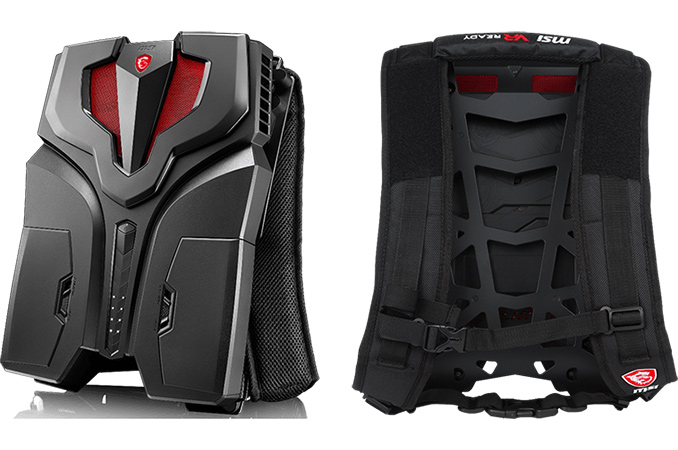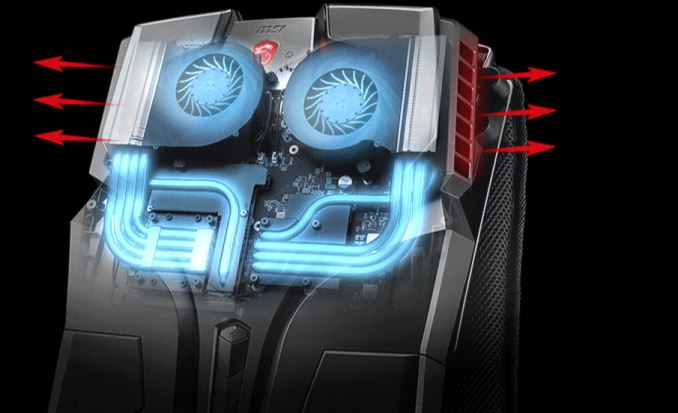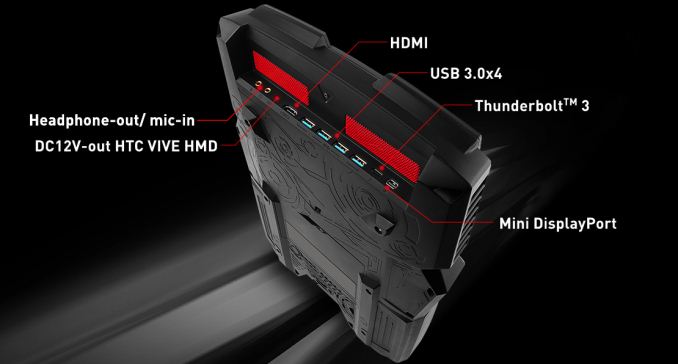MSI Releases the 'VR One': A Backpack PC For VR From $1999
by Anton Shilov on November 21, 2016 10:30 AM EST
MSI has started to sell its VR One backpack PC designed for virtual reality enthusiasts. The MSI VR One system is now available in the US, and comes equipped with an Intel Core i7 and an NVIDIA GeForce GTX 1060/1070. The backpack promises to pack a lot of performance and can even be overclocked. However, the combination of high FPS and a relative freedom of movement is going to cost: the system starts at $1999.
MSI’s VR One backpack PCs rely on the company’s expertise in mobile computing and high-end notebooks. The VR One systems are based on the Intel Core i7-6820HK (4C/8T, 2.7/3.6 GHz, 8 MB LLC, 45 W) processor with an unlocked multiplier as well as NVIDIA’s GeForce GTX 1060 6 GB (VR One 6RD) or GeForce GTX 1070 8 GB (VR One 6RE) GPUs. The key components of the backpack are cooled down using an MSI proprietary cooling system featuring nine heatpipes and two blowers that ensure that the CPU and GPU never overheat even if overclocked (the HM170 chipset supports CPU overclocking). In fact, MSI even supplies its special Shift application that allows the user to boost both the compute and the cooling performance with just a few clicks.
The system comes equipped with a 256 or a 512 GB M.2 PCIe 3.0 x4/NVMe SSD with up to 2.2 GB/s read performance and have another M.2/SATA slot for an additional drive to install more gaming titles. No spinning HDD is equipped by default for obvious reasons.
| MSI VR One Specifications | ||
| VR One 6RD | VR One 6RE | |
| CPU | Intel Core i7-6820HK 4 cores/8 threads 2.7 GHz/3.6 GHz 8 MB LLC 45 W |
|
| PCH | Intel HM170 | |
| Graphics | NVIDIA GeForce GTX 1060 1280 stream processors 80 texture units 48 ROPs 192-bit memory interface 6 GB of GDDR5 8 GT/s memory |
NVIDIA GeForce GTX 1070 2048 stream processors 128 texture units 64 ROPs 256-bit memory interface 8 GB of GDDR5 8 GT/s memory |
| Memory | Two SO-DIMM slots 16 GB DDR4-2133 installed compatible with up to 32 GB of DDR4-2133 |
|
| Storage | 256 GB M.2/PCIe SSD (up to 2.2 GB/s) + one extra M.2/SATA slot |
512 GB M.2/PCIe SSD (up to 2.2 GB/s) +one extra M.2/SATA slot |
| Wi-Fi | Rivet Networks Killer 1535 802.11ac + BT 4.1 | |
| Ethernet | None | |
| Display Outputs | 1 × HDMI 2.0 1 × mDP 1.2 |
|
| Audio | 3.5 mm audio in and 3.5 mm audio out | |
| USB | 4 × USB 3.0 Type-A (5 Gbps) 1 × Thunderbolt 3 (40 Gbps)/USB 3.1 Type-C (10 Gbps) |
|
| Other I/O | DC12V-out for HTC Vive | |
| Dimensions | 409 mm × 292 mm × 54 mm 16.1 × 11.49 × 2.12 inches |
|
| Weight | 3.6 kg | |
| PSU | External | |
| Batteries | 91 Wh | |
| OS | Windows 10 Pro | |
One of the key things about VR gaming backpack PCs is connectivity. The VR One features all the ports needed to connect a VR headset like the HTC Vive with the ports right on top. To simplify connection of the Vive, MSI even supplies a special 3-in-1 cable with HDMI, USB 3.0 and power wires. Moreover, the system packs the Rivet Networks Killer 1535 Wi-Fi 802.11 ac + Bluetooth controller as well as Intel’s Alpine Ridge controller to enable one USB-C/Thunderbolt 3 port.
The whole design of VR One’s motherboard resembles the design of MSI's gaming laptops, which helps to make the PC relatively thin (54 mm) and relatively light (3.6 kilograms). Meanwhile, two hot-swappable batteries enable MSI’s VR One to work completely autonomously for about 1.5 hours each. In fact, the whole outside design of the MSI VR One is optimized primarily for backpack, not desktop operation (unlike ZOTAC’s VR Go). While the VR One can be put on a desk, it will have to lie down, making its ports less accessible. So, the VR One is a system made primarily for virtual reality gaming, not for general-purpose computing.
Right now MSI offers the VR One 6RD with the GeForce GTX 1060 and a 256 GB SSD for $1999 in the U.S. The more advanced VR One 6RE with the GeForce GTX 1070 and a 512 GB SSD will be available a little later for $2299.
Related Reading:
Source: MSI




_thumb.png)
_thumb.png)
_thumb.png)
_thumb.png)
_thumb.png)
_thumb.png)








20 Comments
View All Comments
Retired Budget Gamer - Monday, November 21, 2016 - link
Price should be halved or open a store and rent them.JeffFlanagan - Monday, November 21, 2016 - link
These are only useful for VR Arcades. For home use, a wireless adapter for the Vive is now available in China, and will be available world-wide.RaichuPls - Monday, November 21, 2016 - link
Wireless adapters introduce latency, and you still need a way to power the Vive...jkostans - Monday, November 21, 2016 - link
There is a battery built in (2-5 hours), 2ms of latency. No measurements yet to confirm however.inighthawki - Monday, November 21, 2016 - link
Agreed on latency, but powering such a device is hardly an issue. The battery pack needed to power it for even just a few hours would be pretty compact and could likely attach to the device with ease. It would be no more convenient than whatever wireless dongle you'd be attaching in the first place.BrokenCrayons - Monday, November 21, 2016 - link
It seems like a laptop with its screen removed and a couple of padded shoulder straps. Given there's less hardware than a comparable laptop, I'm guessing the price premium is due to MSI's expectation that they're not going to sell large numbers of these things.negusp - Monday, November 21, 2016 - link
They should manufacture pads and straps that you can mount on your laptop (maybe throw in a fan or two) for less than $100 and hold down the screen. So much more worth than this contraption.Newer gaming laptops have impressive battery packs too.
BrokenCrayons - Tuesday, November 22, 2016 - link
Basically, a cooling fan pad that had a set of adjustable clamps would do that kind of job pretty well. I expect it'd be less expensive and the arrangement would be more flexible since it'd be a simple matter to remove the laptop and put it to use in a more conventional manner. Dedicated systems like these, aside from offering hot swap batteries, wouldn't have much of an advantage that would justify their costs if such things existed.AnimalStyleFries - Wednesday, November 30, 2016 - link
laptop batteries aren't made to run at the full power as it would being plugged into the outletMorawka - Monday, November 21, 2016 - link
i'd be suprised if they sold any at all to consumers. a few arcades might take 2-3 each. hardly enough to pay for the expensive tooling those plastic injections machines use.